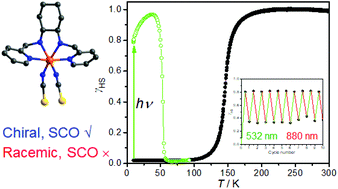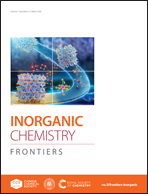Homochiral versus racemic polymorphs of spin-crossover iron(ii) complexes with reversible LIESST effect†
Abstract
Homochiral complexes [Fe(RR-L)(NCSe)2] (RR-1; RR-L = (1R,2R)-N1,N2-bis(pyridin-2-ylmethyl)cyclohexane-1,2-diamine), [Fe(SS-L)(NCSe)2] (SS-1; SS-L = (1S,2S)-N1,N2-bis(pyridin-2-ylmethyl)cyclohexane-1,2-diamine), [Fe(RR-L)(NCSe)2]2 (RR-2) and [Fe(SS-L)(NCSe)2]2 (SS-2) and their racemic analogue complex rac-[FeL(NCSe)2] (rac-1; rac-L is a mixture of an equal ratio of RR-L and SS-L) were synthesized, characterized by single-crystal X-ray crystallography and circular dichroism (CD) spectroscopy, and investigated for their spin-crossover (SCO) behaviours. The enantiomers RR-1 and SS-1 show thermally induced non-hysteretic SCO behaviours centered at 146 K and their polymorphs RR-2 and SS-2 undergo more gradual SCO with a transition temperature of 162 K, while the racemic polymorph rac-1 is unexpectedly high spin only. The differences in SCO behaviours between the homochiral and racemic polymorphs are assigned to different intermolecular interactions. In addition, light-induced excited spin-state trapping (LIESST) effects were found in the four homochiral complexes, and bidirectional photo-switching of spin states can be realized reversibly. These results suggest that we may be able to finely tune the SCO behaviours of polymorphic complexes by alternating chiral and racemic ligands, though chirality itself doesn't exert effects on SCO.



 Please wait while we load your content...
Please wait while we load your content...